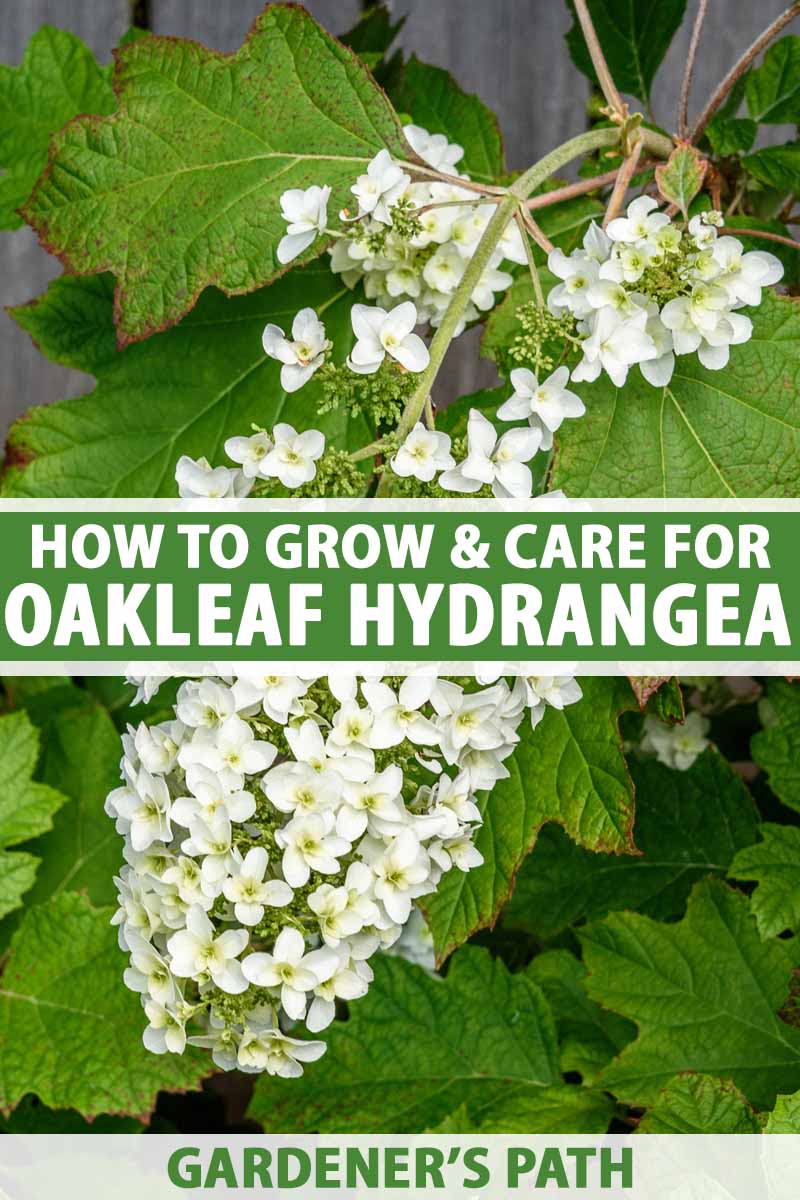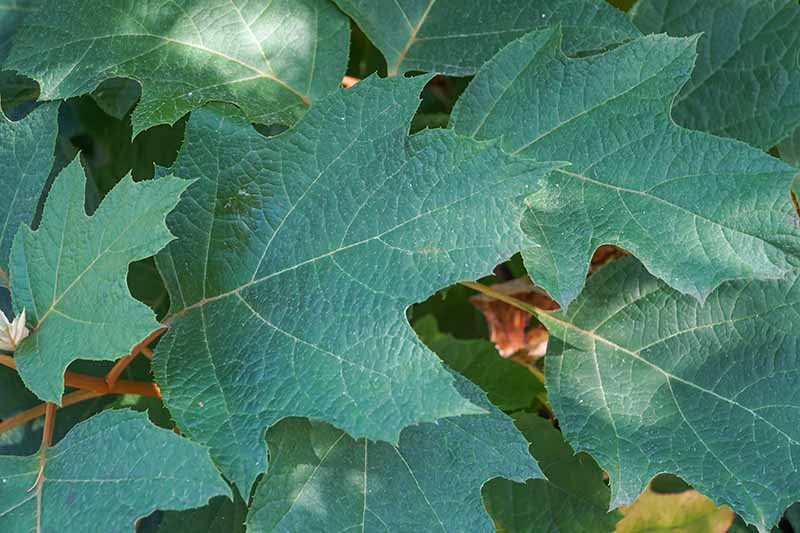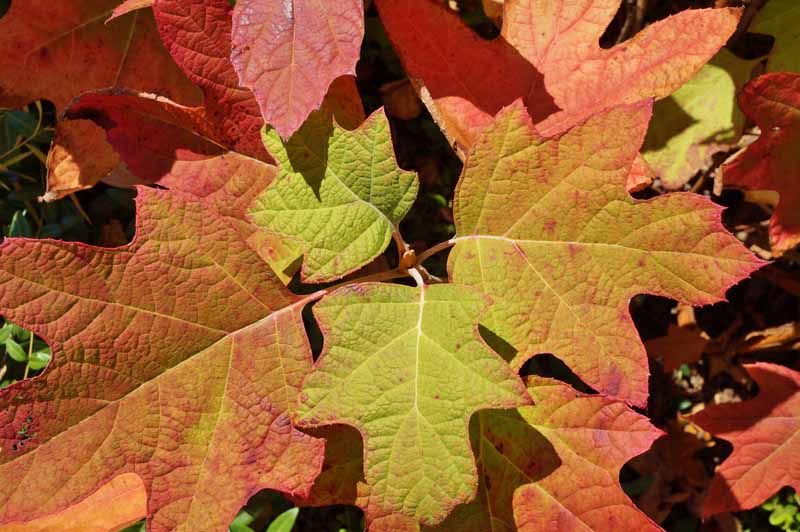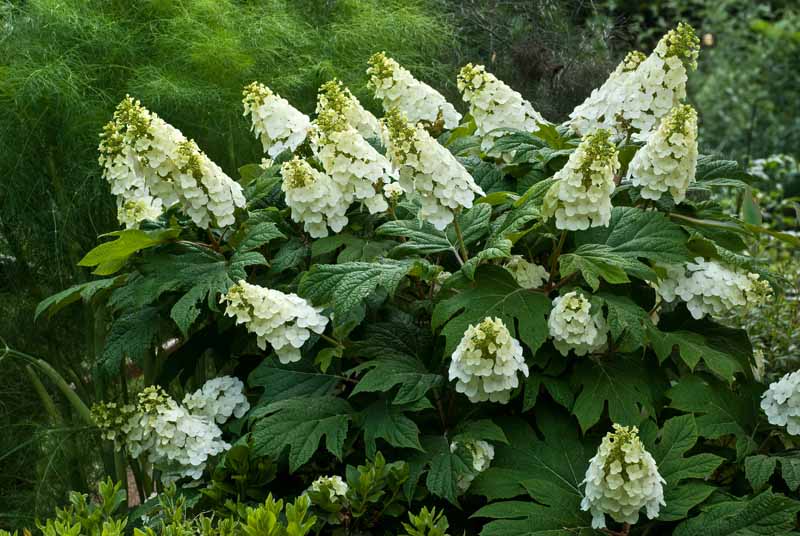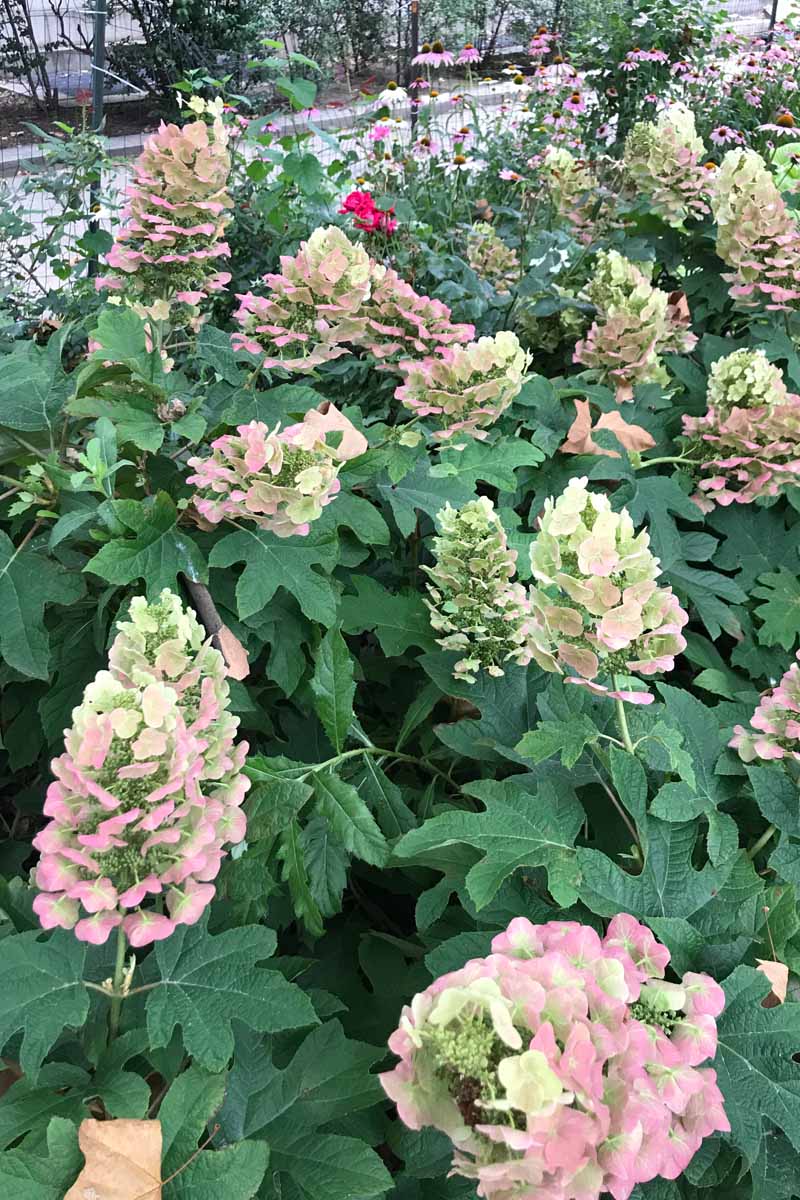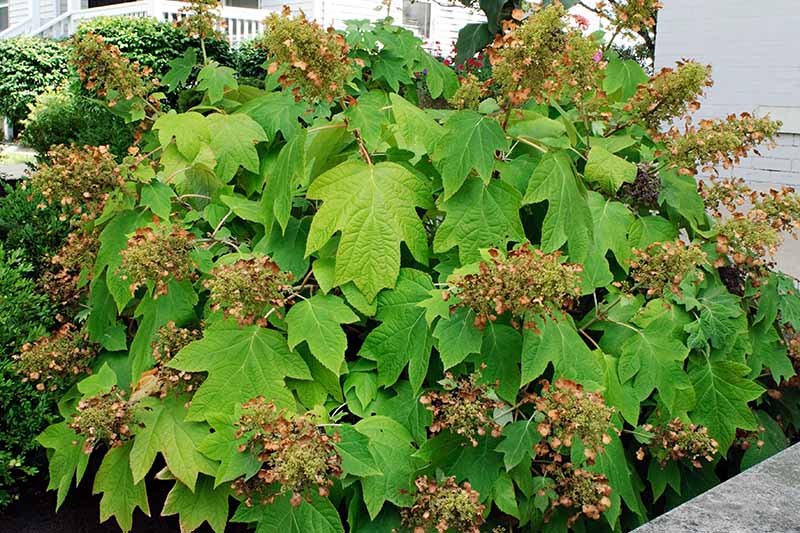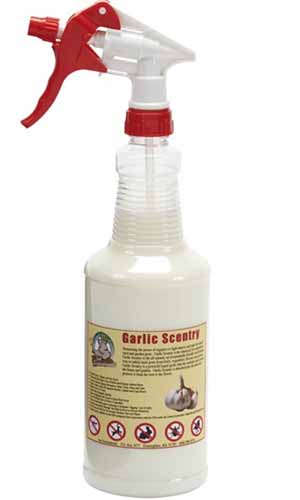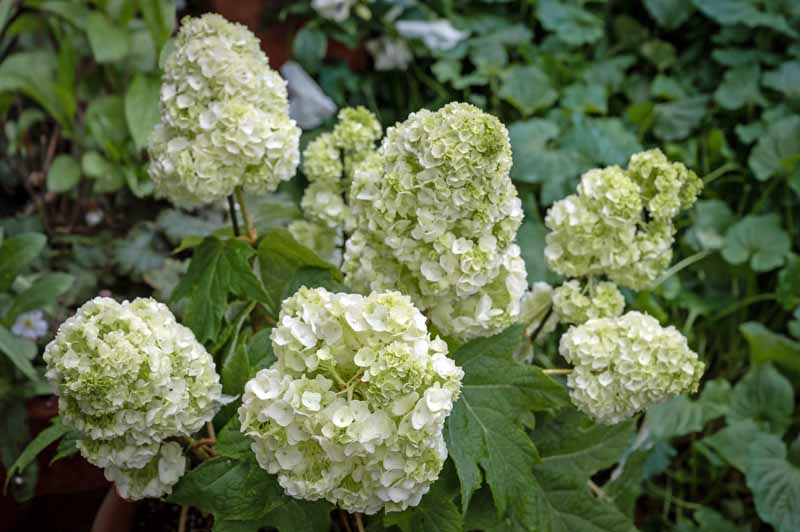Commonly known as oakleaf hydrangea, this plant is native to the southeastern region of the United States. First described and illustrated in 1773 by botanist and writer William Bartram, this woody shrub ranges from Tennessee into North Carolina, west to Louisiana, and further south into Florida. Bartram’s drawings and writings were later published in 1791, in his book “Travels.” Are you looking for a uniquely beautiful, versatile, and easy to grow plant? Let’s take a walk with Bartram through the garden. We link to vendors to help you find relevant products. If you buy from one of our links, we may earn a commission. We’ll learn which oakleaf is best for your location – whether you have a container to fill, or a large space in your landscape – and why this plant is one our favorite shrubs to add seasonal interest and simple elegance to your garden. First, let’s learn a bit more about the history of H. quercifolia. Then we’ll dig into some helpful tips and tricks for growing this special shrub.
What Is Oakleaf Hydrangea?
H. quercifolia is a woody, deciduous, shade-loving shrub native to the southeastern region of the United States, with leaves resembling that of an oak, a shape that’s strikingly different from the rounded leaves of other types of hydrangeas. Perhaps Bartram described their shape best, writing, “the leaves which clothe the plants are very large, pinnatifid or palmated, and serrated or toothed, very much resembling the leaves of some of our oaks.” These oak-like leaves add texture to garden spaces, and draw attention with their unique look throughout much of the year. The gorgeous fall color changes that they exhibit are an added bonus. Long, graceful panicle blooms are a feature of this species, and buds form on old wood. Unlike other types of hydrangeas with rounded clusters of blossoms, oakleafs feature many multibranched clusters of flowers (aka racemes) with panicles that culminate in pointed tips. These are noted by Bartram for their “dark rose or crimson colour,” and the flowers “are of two kinds: the numerous partial spikes which compose the panicles, and consist of a multitude of very small fruitful flowers, terminate with one or more very large expansive neutral or mock flowers, standing on a long, slender, stiff peduncle.” The flowers do not change color with changes to soil pH, like other hydrangeas can. Blooms emerge greenish white, and then change color as the seasons progress, regardless of the acidity or alkalinity of the soil they are growing in. Species H. quercifolia blooms turn from white to pinky red to brown. Cultivars are similar in their changes, but have been bred to exhibit more vibrant colors as the blooms age. Dwarf-sized ‘Ruby Slippers’ transforms to a stunning, long-lasting, deep russet red color. This variety would be perfect in a large container – but more on that later. Leaves also change color in the fall, often to a brilliant crimson, or dark purple. These colors fade somewhat, but can persist until the leaves fall from the plants, usually sometime in January upon the arrival of howling cold winds. As the plants mature, the bark begins to peel, creating exceptional winter interest. Bartram writes of how the multi-branching stems “… are covered with several barks or rinds, the last of which being of a cinereous dirt colour and very thin, at a certain age of the stems or shoots, cracks through to the next bark, and is peeled off by the winds.” The cinereous bark – meaning it resembles ashes or has a gray color mixed with black – is a fascinating feature of the bare wood in winter. After the leaves have fallen from mature plants, the exfoliating bark may remind you of a paperbark maple. It peels away to expose the brown to reddish-orange colored stems underneath. The unusual leaf style, and spectacular fall leaf colors, mean H. quercifolia will pop in any garden. Particularly suited to southern zones, as long as there is afternoon shade available to provide protection from strong sun, these versatile shrubs will complete any outdoor space. These plants are also very well suited to climates further north. They can be placed in sunnier areas in gardens north of Zone 7. And they will still bloom well, even in shade.
Cultivation and History
Other types of ornamental hydrangea seem to bloom better in the northern US. H. quercifolia is the answer to that problem for southern gardeners hoping for lots of blooms, and it performs best in the south. Providing four seasons of interest – including gorgeous fiery fall impact – makes an oakleaf the perfect choice for any garden within its recommended range. Do you garden in Zone 5a and have a sunny spot that’s protected from winter wind, or is your garden in Zone 9 and you have a very shady spot, especially in the afternoon? At these extremes and just about everywhere in between, this shrub is a fabulous choice, and it’s hardy in Zones 5 to 9. H. quercifolia is the state wildflower of Alabama, and can be found growing throughout the state. Botanist William Bartram described oakleaf hydrangea as a new species, and he named it with the unique, unusual leaves that he saw in mind. “Quercus” denotes oaks, and “folia” is the Latin word for leaves. Breeders first began producing cultivars of the species plant in the early to mid-20th century. ‘Snow Queen’ and ‘Pee Wee’ were created early in the 1900s, and were used later as parent plants in a breeding program that began in 1996, at the US National Arboretum’s work site in McMinnville, Tennessee. According to Agricultural Research Service geneticist Dr. Sandra Reed, the goal of the program was to create compact cultivars for use in residential gardens. Newer cultivars such as ‘Ruby Slippers’ and ‘Munchkin’ have since become popular favorites in many areas, due to the versatility they offer in terms of size, and their magnificent capacity to bloom in the shade. Described by Pat Broyles, a soil conservationist based in Manhattan, Kansas working with the USDA’s Plant Materials Program, this species bears cultural significance.
Native Cherokee people used parts of the plant for medicinal purposes. Scrapings of the bark were used to make a poultice to treat burns, a tea was created from the roots and used to treat kidney stones and other urinary diseases, and a tea made from the leaves was used to induce vomiting. Herbal lore passed down through the generations in the mountains of western North Carolina also suggests a remembered use of the plant to “bust up stones,” meaning it could be used to break up kidney stones.
Propagation
Taking a cutting may seem like the obvious choice for propagating woody shrubs, but this plant can also be propagated by seed (though results may vary), or by a technique called layering.
From Seed
H. quercifolia is easily propagated from seed, and should germinate in less than two weeks after planting. Having said that, growing plants isn’t just about germination, though that can be an important first step. Oakleaf cultivars and hybrids produce viable seed, but remember that seeds collected from these do not produce clones of the parent plant like a cutting would, and they may produce plants with unexpected characteristics instead. As such, seeds are not readily available to purchase. If you still wish to give seed propagation a shot, it’s best to collect the dried seed heads on existing plants in late fall or early winter. Seeds may also be sown outdoors after the last frost date in your zone. CowPots CowPots are a nice option that makes transplanting easy. These biodegradable six-cell trays are available from Arbico Organics. Seeds may be sown indoors about two to four weeks before the last frost date for your area. Plant three to five seeds per cell. Sowing directly into a prepared bed consisting of well drained, organically rich soil may be slightly less effective than starting seeds indoors in greenhouse conditions, but you may still have some luck. Scatter the seeds by hand, rake them lightly into the soil, and water. Continue to water every other day or so until seedlings emerge. Then you can decrease watering to twice weekly, if there is no rain. When seedlings grow their second set of leaves, they should be thinned to one seedling per cell. If you hate this part, you could also give sowing just one seed per cell a shot, with no thinning required. Watering from below is also recommended. Avoid sprinkling the leaves and stems with water, as this can lead to disease problems like powdery mildew or rot. Seedlings must be hardened off before transplanting to two-gallon containers. They can be placed outside in a shady spot after the last average frost date in your area, to begin to acclimate. Do not place young seedlings in direct afternoon sun. Start with an hour on the first day before bringing your seedlings back inside, and increase the total time by an hour each day until you can keep them outdoors for a full eight hours. You can expect seedlings to take about seven months to one year to graduate from cell packs into two-gallon containers, and plants in two-gallon containers are usually ready for transplant into the ground in early to mid-fall of the planting year. The average size when it’s ready to transplant is dependent on the cultivar. Timing is key. It is important to transplant them before it’s too late in the fall season. Plants growing in containers do not overwinter as well as those growing in the ground, and they may freeze and die if left unplanted. Read more about collecting and planting hydrangea seed here.
From Cuttings
H. quercifolia can be difficult to propagate from cuttings, but it’s not impossible. The method is the same as it would be for other types of hydrangeas. The cuttings should be taken at the proper time of year – usually from late spring to early summer, which is the primary growth period for this species. This timing will ensure the best chance of developing roots. According to horticulture professors Michael Dirr and Charles Heuser, cuttings taken later in the year generally have a very low rate of root growth. Planting in a porous and sterile seed starting mix which contains at least 30 percent perlite or vermiculite will help to retain proper moisture levels for tiny, tender roots to grow in, and will stimulate new root growth. Dip the cuttings into rooting hormone powder. Then, transfer each to a six to 12-inch container filled with the soil mixture. Keep it moist white roots and new growth develop. Learn more about how to grow hydrangeas from cuttings in our guide.
Via Ground Layering
These shrubs are best propagated using a technique called ground layering. Because the branches are often low growing, you can easily place the lower branches in contact with the soil, and bury the stem. You may need to secure the stem with a clip, or place a weight like a brick on part of the stem to ensure it remains in contact with the soil. Allow the area to remain undisturbed throughout the growing season to ensure that root growth has occurred. The new clone can be cut from the “mother” plant with pruners, and transplanted to your selected location.
Transplanting
Dig a hole slightly deeper than the container your oakleaf is growing in, and twice as wide. Amend the soil as needed (a bit of mushroom compost and soil conditioner is one option), then plant the crown of the root ball a bit higher than the surrounding earth. Planting “high” in this way is a good idea for many varieties of shrubs, to anticipate any settling of the soil that may occur over time, and to ensure good drainage.
How to Grow
Because these amazing beauties can bloom in full shade, unlike other types of hydrangeas that need at least three to four hours of sun per day to bloom well, the shadiest spot in your garden can be bursting with flowers. But remember: oakleaf hydrangeas require afternoon shade in the southern US. Typically found growing in the wild by shady riverbanks, they may also do alright in sunnier spots in cooler climates within their range, and they can tolerate full sun in Zones 5 and 6. The use of the term “full sun” is relative when it comes to plants, because the strength of the sun increases as you move further south. So, even if a plant tag says full sun, that may not always mean it will take full sun in your particular zone. The leaves will droop and look wilted if they receive direct sun between noon and 4 p.m. in Zone 7, or points further south. The northeastern side of the house is a perfect location to plant your shrub, especially in Zones 7 to 9. This area should get less afternoon sun than other places in your landscape, with the structure protecting them from the strong sun. There are no special requirements for these in terms of soil needs. Though oakleaf hydrangeas prefer sandy, organically rich soil, much like that of their native riverbank environments, they can tolerate slightly acidic clay soil, as well as other types. In the first few years until plants become established, they will need a lot of water. Water several times per week if there is no rain. Plants will do best with at least one inch of water per week. They are very tolerant of moist areas, and can be placed in locations many other types of plants would find too wet. However, they do not like to continuously sit in standing water for long periods, so good drainage is recommended. Once plants are established (usually after one year of growth), they will tolerate drier conditions, and you will not need to water as often. Irrigating once per week should be sufficient if you receive no rain. Mature shrubs are drought tolerant and can go for weeks without additional watering. If the leaves look wilted or droopy at all times – not just in extreme summer heat or direct sun, but beyond the hottest point in the day as well – then your oakleaf may be thirsty. Water the soil under the plants thoroughly and completely for 10 to 15 minutes, until it is fully saturated. If you wonder exactly how much rain you are actually receiving, then a rain gauge is what you need. This can help you to know how many inches of rainwater you receive per week, and whether you need to provide more water for your plants. It’s best to fertilize in the summer, once a month from May to July. Fertilize just around the “drip line,” or the perimeter of the leaf canopy. Don’t place fertilizer too close to the stem, or it can burn the plant. I use a granulated organic fertilizer once per month while my shrubs are actively blooming. These plants can do well in lean soil, and it’s okay to skip a month here or there, but you will get more blooms if you amend with fertilizer.
Growing Tips
Oakleafs will bloom with very little sun, unlike other hydrangeas that need at least 3-4 hours per day to bloom profusely.They love water, and thrive in wetter areas where other plants would rot. But mature plants are also drought tolerant.Protect sensitive new buds in winter in Zone 5 by planting in a protected location.
Pruning and Maintenance
Do you want a shrub that needs very little maintenance, and looks even better when you don’t prune it? Then, look no further because these super low-maintenance plants need very little pruning. Espoma is my favorite brand for satisfying all plant needs. Espoma Plant-Tone Fertilizer Ready to add an oakleaf hydrangea or three to your outdoor space? There are more tips and tricks ahead to maximize the use of these charming, subtle, and simply gorgeous flowering beauties. If deemed necessary, pruning should be done lightly. Prune shrubs back by no more than one-third of the total size of the plant, immediately following blooming. Remove any broken or damaged branches first, and then make your cuts just above a new bud node to encourage growth from those buds. Don’t take too much off, as the buds form on old wood and removing too many will reduce flowering the following season. You may also cut just below old blooms, to tidy up their appearance. Deadheading can be done in the fall after blooming ends, when flower heads are drying out or fully dried, or in the early spring, to improve the overall appearance of the plant. Somewhat slow growing, if you prune too often or take too much off at one time, plants may take quite a while to reach their mature size. Mulch can be applied in summer, to help retain moisture. Try an application of leaf mold, fallen fall leaves, or coarse pine bark mulch every year or two to prevent moisture loss and give the landscape a more polished look. Pine bark and leaves both provide nutrients as they decompose. Add a layer of mulch or leaves about one to two inches thick around the base of the plant. Take care to keep about two inches of unmulched space around the perimeter of the main trunk or stem, to prevent rot. Next year’s flowers only burst into bloom in the spring if the buds developed in the preceding year on old wood are able to survive the winter. In Zone 5 and other areas that experience an especially cold winter, buds are vulnerable to frost damage. Keep an eye on the forecast, and protect plants in advance if possible. Move them to a protected location, or move container-grown plants indoors for protection from harsh winter conditions.
Cultivars to Select
Your garden can sing with the beauty of these unique and understated plants, and there are a variety of options available. Perhaps you want one to fit into a container? Or maybe you would prefer one to provide towering shade you could sit beneath, on a hot summer afternoon? In addition to the species (or wild) variety, cultivars are available in a range of bloom colors, plant sizes at maturity, and growth habits. Some can grow to 15 feet tall, while dwarfs reach only two to three feet tall and wide. Let’s take a look at a few of the top picks.
Alice
If you’re in the market for a tall and large cultivar, ‘Alice’ can reach a tremendous size, up to 15 feet tall. ‘Alice’ makes a beautiful single planting, creating a focal point for your garden. One can be used alone in the center of a bed, surrounded by other shade-loving shrubs like Illicium and azalea. This is the type you might like to sit under for shade, while sipping your iced tea in the summertime. And it features panicle blooms up to 12 inches long! This cultivar has more in common with a small tree at maturity than a shrub. It is super pretty with the sunlight streaming through the orange, red, and yellow leaves in the fall. Just make sure you have enough space available for this one to grow into.
Snowflake
‘Snowflake’ is an old fashioned midsize beauty with heavy, drooping, graceful clusters of white flowers that age to a soft charming pink. ‘Gatsby Pink’ Still quite a large plant, this hot pink bloomer is stunning to look at in all seasons. Plants are available from Nature Hills Nursery.
Pee Wee
Hoping to find something else a bit on the smaller side? ‘Pee Wee’ is a densely branched, compact oakleaf with a mounded habit that has a maximum height of four feet, and a spread of two to three feet. ‘Pee Wee’ It is known for its very small flowers and leaves, as compared to other oakleaf varieties. This cultivar will work in a larger sized container, or it can be planted in the front of a mixed border bed. Plants are available from Nature Hills Nursery.
Ruby Slippers
‘Ruby Slippers’ is a newer midsized cultivar, introduced to the market in 2010. Technically a dwarf, it matures to a height of three to five feet. ‘Ruby Slippers’ ‘Ruby Slippers’ is a perfect choice for larger sized containers. It stays compact, and provides lots of color and bloom impact for its size. White flowers age to a deep burgundy red. Plants are available from Burpee. Try placing smaller varieties like ‘Ruby Slippers’ or ‘Pee Wee’ under or near larger companion plants like abelia, gardenia, and camellias, which also do well in part shade.
Sikes Dwarf
‘Sikes Dwarf’ is an excellent container selection known for its small stature, mounding habit, and mature size of just two to three feet. This super compact dwarf cultivar will fill a 30-inch container nicely, with room for some annuals to be added around the base. Try begonias, impatiens, or ferns. This cultivar can be used in mixed border beds and mass plantings to deliver maximum impact in the landscape. Mature shrubs can spread to four feet, and reach heights of four to six feet. Plant three to five of these, spaced five feet apart or so. Then, fill in around the shrubs with perennials like hostas, heuchera, Carex ‘Evergold’ (a popular evergreen shade grass), and other shade-loving perennials.
Managing Pests and Disease
There’s an added bonus in this category of care: Oakleaf hydrangeas are significantly less susceptible to common diseases than other types. Even so, they may still fall prey to certain pests and pathogens. Here are the main culprits to keep an eye out for:
Herbivores
Deer are a major problem for these plants, and they love to eat the leaves. In fact, they will totally destroy them! They will eat every single leaf off the entire plant, in one night. Deer are rarely brave enough to venture that close to the house, as long as it’s a place that you visit regularly. Garlic Scentry Spray Try Garlic Scentry spray from Just Scentsational to repel deer, available from Tractor Supply Company. If you don’t have a fence, plant them in an area where the animals might not be as eager to stop and snack, such as a shady high-traffic area close to the back deck or porch.
Insects
Aphids and spider mites can sometimes cause a problem. Japanese beetles will try a taste of the tender leaves from time to time. A spray of cayenne pepper powder mixed with water will usually discourage them, at least temporarily. Reapply as needed. Read more about ridding the garden of Japanese beetles here.
Disease
H. quercifolia is very rarely affected by disease, but if you do have problems, consult our guide on how to identify and treat hydrangea diseases. Bacterial leaf spot is the most common ailment of the oakleaf type. Mulching under the plants each summer helps to minimize water loss, and also helps to eliminate splashing from the soil onto the leaves, decreasing the risk of disease spread.
Best Uses
Whether planted as single specimens, in a mixed border, or in containers, a variety of options are available to use this lovely shrub in your landscape. A single plant can make a big impact. Choose a larger cultivar like ’Alice’ or ‘Gatsby Pink’ for a spectacular display of blooms. Plant several to create a larger focal point. The medium-size cultivars like ‘Snowflake’ and ‘Ruby Slippers’ make super foundational plants for a mixed border bed. Try mixing H. quercifolia with other shade-loving perennials for a stunning and spectacular display! Choose small and impactful ‘Sike’s Dwarf’ and ‘Pee Wee’ cultivars for a perfect container planting. Container-grown oakleafs can be just as enjoyable, and conditions are often easier to control than they may be for in-ground plantings. You can move the container to the perfect position, or even bring it inside to shelter through the winter if you live north of Zone 5, and still want to experience the beauty of these captivating shrubs. Cut fresh or dried flowers may be used to create bold and breathtaking floral arrangements. These long-lasting reminders of summer’s splendor provide another level of enjoyment, and brighten indoor spaces. We’ve learned a bit about the history and use of this plant, and we’ve discovered a functional, versatile, shade-loving shrub that provides unusual interest in Zones 5 to 9. This lovely and distinctive blooming woody wonder has all the best to offer if you’re looking for a low-maintenance shrub that blooms profusely in shade. It provides four seasons of beauty with an intriguing display of charming leaves and blossoms, spectacular fall colors, and winter bark features. Make the unique, understated, stunning, versatile oakleaf hydrangea a part of your garden today! We welcome your comments, or any questions you may have. Please reach out in the comments section below. Do you want even more information on hydrangeas, and how to grow and care for them? Take a look at these guides next:
How to Grow Hydrangeas for Big Blossomed BeautyHow to Grow and Care for Panicle Hydrangea7 Reasons Why Your Hydrangea May Not Bloom
